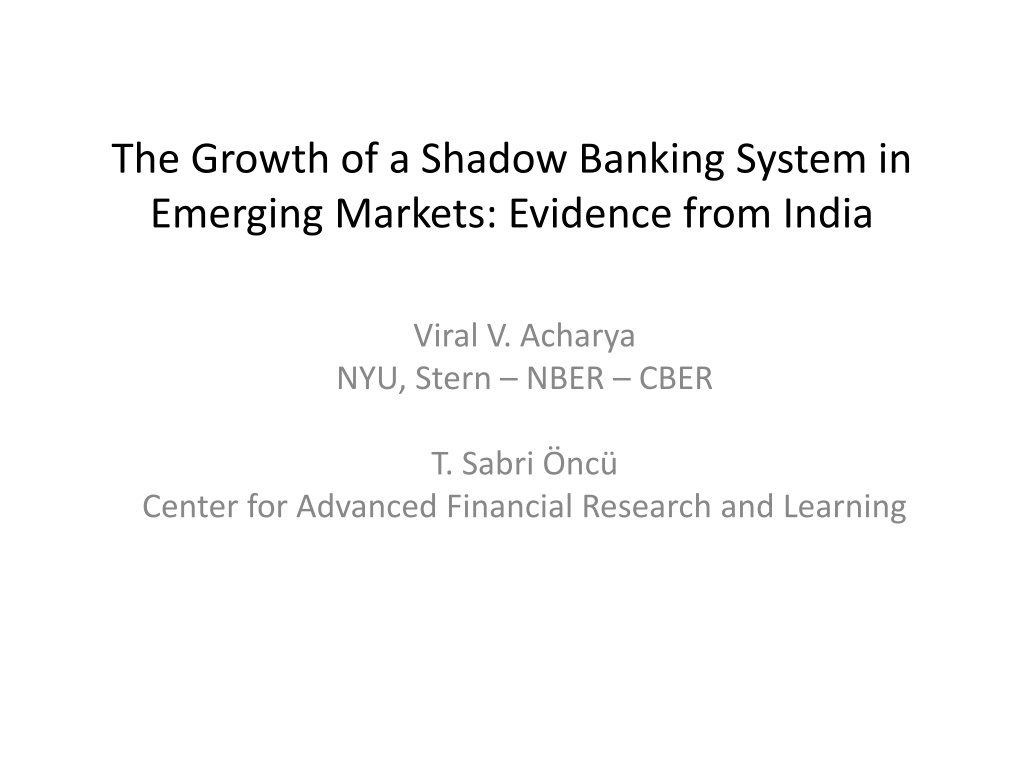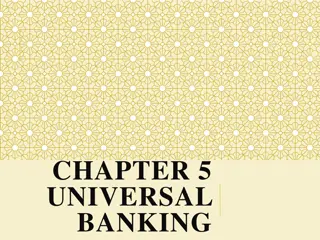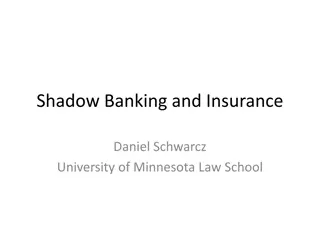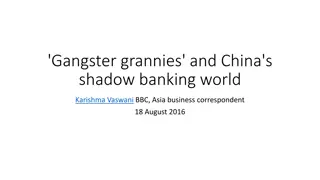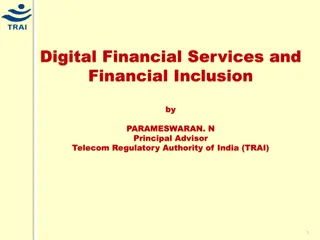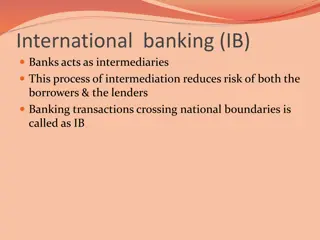Understanding the Growth of Shadow Banking in Emerging Markets: Insights from India
Investigating the rapid expansion of nonbank finance corporations (NBFCs) in India reveals insights into the incentives driving the development of shadow banking institutions. Key factors explored include economic considerations, regulatory disparities, and asset-liability structures. The concept of shadow banking, its characteristics, and role in credit intermediation outside traditional banking systems are also examined.
Download Presentation

Please find below an Image/Link to download the presentation.
The content on the website is provided AS IS for your information and personal use only. It may not be sold, licensed, or shared on other websites without obtaining consent from the author. Download presentation by click this link. If you encounter any issues during the download, it is possible that the publisher has removed the file from their server.
E N D
Presentation Transcript
The Growth of a Shadow Banking System in Emerging Markets: Evidence from India Viral V. Acharya NYU, Stern NBER CBER T. Sabri nc Center for Advanced Financial Research and Learning
Objective of the Study To investigate the rapid growth of the nonbank finance corporations (NBFCs) in India to understand incentives underlying the formation of shadow banking institutions, if any. Our hypotheses for the growth and relative characteristics of NBFCs will include: purely economic reasons for coincidence of certain asset-liability structures; the role played by regulatory differences in: licensing requirements; asset restrictions; asset recovery privileges; foreign investment restrictions; priority sector norms, etc. 2
Scope of this Talk We are still in the process of finalizing our data needs. Therefore, the scope of this talk is limited to: an overview of the Indian NBFC market; our analysis of publicly available NBFC data. 3
What is Shadow Banking? Shadow Banking is an evolving concept. Many non-intersecting but non-contradictory definitions. However, below are the key points emerged so far: Maturity, credit and liquidity transformation outside the traditional banking system; Less regulated than the traditional banking system or not regulated at all; No explicit access to central bank liquidity or public sector credit guarantees; 4
What is Shadow Banking? Highly levered; Assets are risky and illiquid; Liabilities are prone to bankruns ; Decomposes the process of credit intermediation into a sequence of discrete operations. Therefore, it can be a collection not only of single financial entities acting independently, but also of (and usually is) networks of multiple financial entities acting together or both: banks, formal and informal nonbank financial institutions, and even credit rating agencies, regulators and governments. 5
Commercial Banks Public Banks Private Banks Foreign Banks (36) State Bank of India and Associate Banks (6) Old Private Banks (14) Nationalized Banks (20) New Private Banks (7) Regional Rural Banks (82) 6
NBFCs Deposit taking NBFC-D Non-deposit Taking Systemically Important NBFC-ND-SI Asset Finance Company Asset Finance Company Loan Company Loan Company Investment Company Investment Company Core Investment Company Residual NBFCs Infrastructure Finance Company 7
Classification of NBFCs Activity Based Asset Finance Company is a company: carrying on as its principal business the financing physical assets supporting productive/economic activity: autos, tractors, material handling equipments, etc. Loan Company is a company: carrying on as its principal business the providing of finance whether by making loans or advances or otherwise for any activity other than its own. Investment Company is a company: carrying on as its principal business the acquisition of securities. Core Investment Company is an investment company whose: 90% of Net Assets in equity shares, preferred shares, bonds or loans of a group of companies or 60% of Net Assets in equity shares of a group of companies. Infrastructure Finance Company is a company which: deploys at least 75 per cent of its total assets in infrastructure loans. 8
Classification of NBFCs Organization Based Standalone NBFCs; Bank and Financial Institution (B&FI) Sponsored NBFCs: according to the RBI, there are 28 currently: 18 sponsored by foreign banks and financial institutions; 10 sponsored by Indian banks. Captive NBFCs: set up to put the parent company's products within the reach of consumers and to ensure that the company has a steady pool of buyers; any major challenges confronting the parent could threaten the operations and asset values of the captive NBFC. Multiple NBFCs: companies which have multiple NBFCs within their group; example: Shriram Group; their argument is that operational efficiencies arising out of specialization, dynastic reasons, tax planning were some of the reasons given for multiple NBFCs. 9
Regulatory Differences between Banks and NBFCs Requirement Banks NBFC-Ds NBFC-ND-SIs Liquidity as % of Demand and Time Deposits Cash Reserve (CRR) 6% NA NA Statutary Liquidity (SLR) 24% 15% NA Capital as % of Risk Weighted Assets (CRAR) 9% 15% 15% Priority Sector Lending as % of Total Credit 40% NA NA Nonperforming Asset Norms (Days in Delinquency) 90 180 180 Restriction of Financial Activity YES NO NO Restrictions of Foreign Ownership YES NO NO 10
Growth of the NBFC Sector 800 16000 NBFC-D NBFC-ND-SI 700 14000 600 12000 500 10000 400 8000 300 6000 200 4000 100 2000 0 0 2000 2004 2000 1999 2001 2002 2003 2005 2006 2007 2008 2009 2010 2011 1999 2001 2002 2003 2004 2005 2006 2007 2008 2009 2010 2011 Number of All NBFCs Number of NBFC-Ds and NBFC-ND-SIs 11
Consolidated Balance Sheet of NBFCs Trillions of Rupees FY06 %FY06 FY10 %FY10 FY11 %FY11 Liabilities Share Capital Reserves & Surplus Public Deposits Borrowings B&FI Loans Current liabilities Total Liabilities Assets Loans and Advances Bill Business Hire Purchase Assets Investments Cash and Bank Balances Other Current Assets Other Assets Total Assets 0.2215 0.4774 0.2284 2.0760 0.6231 0.3027 3.3060 100.00% 6.70% 14.44% 6.91% 62.79% 18.85% 9.16% 0.4328 1.3931 0.1735 4.4986 1.3172 0.5114 7.0094 100.00% 6.17% 19.88% 2.48% 64.18% 18.79% 7.30% 0.4722 1.5868 0.1196 5.7075 1.8384 0.5863 8.4725 100.00% 5.57% 18.73% 1.41% 67.37% 21.70% 6.92% 1.6945 0.0005 0.4472 0.8163 51.25% 0.01% 13.53% 24.69% 4.1964 0.0005 0.4169 1.5218 0.2586 0.4057 0.2097 7.0094 100.00% 59.87% 0.01% 5.95% 21.71% 3.69% 5.79% 2.99% 5.3607 0.0009 0.5002 1.6413 0.2988 0.4244 0.2462 8.4725 100.00% 63.27% 0.01% 5.90% 19.37% 3.53% 5.01% 2.91% NA NA NA NA 0.3476 3.3060 100.00% 10.51% NBFCs include NBFC-D, NBFC-ND-SI and RNBCs 12
Comparison between NBFC and Bank Sectors Trillions of Rupees FY06 FY10 FY11 Number of NBFCs 13,014 12,630 12,409 Bank Credit of all Scheduled Banks 15.728 33.377 40.608 NBFC Credit as percentage of Bank Credit 10.77% 12.57% 13.20% Assets of all Scheduled Banks 25.315 52.58 61.47 NBFC Assets as percentage of Bank Assets 13.06% 13.33% 13.78% Bank Deposits of all Scheduled Banks 21.858 46.352 53.552 NBFC Public Deposits as percentage of Bank Deposits 1.05% 0.37% 0.22% NBFCs include NBFC-D, NBFC-ND-SI and RNBCs Scheduled Banks include Commercial Banks and Cooperative Banks 13
Growth of the NBFC Sector (Excluding RNBCs) 12.0 NBFC-D NBFC-ND-SI NBFC-D NBFC-ND-SI 7.0 10.0 6.0 5.0 8.0 4.0 6.0 3.0 4.0 2.0 2.0 1.0 0.0 0.0 2006 2007 2008 2009 2010 2011 2006 2007 2008 2009 2010 2011 Assets in Trillions of Rupees Assets as percentage of Assets of Banks 14
Sources of Funds of NBFCs Trillions of Rupees FY06 %FY06 FY10 %FY10 FY11 %FY11 Share Capital 0.210 6.98% 0.404 6.22% 0.442 5.61% Reserves and Surplus 0.489 16.29% 1.422 21.89% 1.617 20.50% Public Deposits 0.228 7.61% 0.174 2.67% 0.120 1.52% Borrowings 2.076 69.12% 4.499 69.22% 5.708 72.37% B&FI Borrowings 0.623 20.75% 1.317 20.27% 1.838 23.31% Debentures 0.681 22.69% 1.561 24.02% 2.053 26.04% Intercorporate Borrowings 0.195 6.48% 0.222 3.41% 0.249 3.16% Commercial Paper 0.131 4.37% 0.310 4.78% 0.323 4.10% Other Borrowings 0.446 14.84% 1.088 16.75% 1.244 15.77% Total 3.003 100.00% 6.499 100.00% 7.886 100.00% NBFCs include NBFC-D, NBFC-ND-SI and RNBCs 15
Leverage of the NBFCs: Borrowings/Total Assets (Excluding RNBCs) B&FI Debentures Total Borrowings B&FI Debentures Total Borrowings 80% 80% 70% 70% 60% 60% 50% 50% 40% 40% 30% 30% 20% 20% 10% 10% 0% 0% 2007 2008 2009 2010 2011 2007 2008 2009 2010 2011 NBFC-D NBFC-ND-SI 16
Leverage of the NBFC-Ds: Borrowings/Total Assets (Excluding RNBCs) B&FI Debentures Total Borrowings Government B&FI Debentures Total Borrowings 80% 80% 70% 70% 60% 60% 50% 50% 40% 40% 30% 30% 20% 20% 10% 10% 0% 0% 2007 2008 2009 2010 2011 2007 2008 2009 2010 2011 Asset Finance Companies Rest 17
To Sum Up We are still in the process of finalizing our data needs; Our hypotheses for the growth and relative characteristics of NBFCs will include: purely economic reasons for coincidence of certain asset- liability structures; the role played by regulatory differences in: licensing requirements; asset restrictions; asset recovery privileges; foreign investment restrictions; priority sector norms, etc. 18
